Newsletter of the 14 Squadron Association
Mike Napier
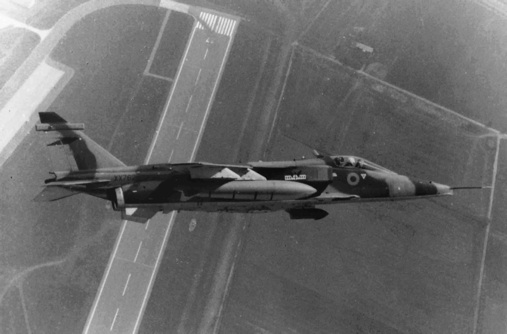
A fine shot of a Jaguar GR1 of 14 Squadron
The Squadron operated this aircraft from Bruggen between 1975-85 and was the RAF’s first and last single-seat Strike/Attack squadron
RAF Museum
Hon Sec’s Bit
2007 Reunion
The 2007 Reunion was held at RAF Cottesmore on 16 November and was attended by 48 members - which is a healthy number. We would have made it into the 50s but unfortunately we lost our “top cover,” in the form of our President AVM Deryck Stapleton and Vice President AVM Tim Anderson who were both indisposed on the night and were unable to attend. The venue at Cottesmore was superb - we had the run of the place to ourselves with some excellent food and good beer at reasonable Mess prices! We were particularly delighted that 3 of the Squadron’s Tornado aircraft flew down from Lossiemouth to join us, including OC 14 Squadron Wing Commander Adrian Frost. After the meal Adrian gave a fascinating presentation on the present 14 Squadron’s activities. Those who were interested (ie most of us!) were able to look round a Tornado aircraft in the hangar the next day.
Those attending the Reunion were: Mac Furze (Vice President of the Association - 1960s), Stewart Airey (‘60s), Bob Broad (‘50s), JJ & Sue Burrows (‘80s), Steve & Liane Cockram (‘80s), Marcus Cook (‘90s), Nige & Sarah Cookson (‘00s & ‘90s), Des Coughlan (‘60s), Ernie Coppard (‘60s), John & Sue Craig (‘90s), Alison & Amy Donovan (‘90s), Brian Dutton (‘40s), Arthur Galilee (‘40s), John & Mary Galyer (‘60s & 70s), Andy & Julia Jeremy (‘80s), Derek Jordan (‘60s), Darren & Catherine Legg (‘90s), Mike & Shani Napier (‘80s & ‘90s), John Newland (‘60s), Snip Parsons (‘50s), Malcolm Pluck (‘60s), Dougie Potter (‘90s & ‘00s), Paddy Shiels (‘60s), Smudge & Brenda Smith (‘50s), Douglas & Georgia Steer (‘80s & ‘90s), Geoff Steggall (‘50s), Stu & Jenny Wain (‘80s), Bill Yates (‘60s), Larry Williams (‘90s)
The Squadron was represented by: Adrian Frost, John Upwood Tom Sawle and Susanna Bones, Trevor Dugan, Jamie Buckle and Adrian Mellors [My apologies if this latter list is not absolutely correct - I know that there were some substitutions on the night and my records weren’t completely updated!] It was particularly good to see some representatives of the groundcrew amongst that number.
Once again we had a great mix of ex-Crusaders from representatives of the wartime generation (Brian Dutton - Blenheims and Arthur Galilee - Wellingtons) through representatives of all the decades in between up to the present time. I think that the reunion was the first time that Bob Broad, Geoff Steggall and Smudge Smith had seen each other for half a century!
Apologies were received from the following: Tom Boyle (‘90s), Ron Dawson (‘40s), Adam Fox-Edwards (‘80s & 90s), Ed Jones (‘60s), Tony Gregory (‘90s), Mike Levy (‘50s), Tim Marsh (‘80s), Douglas Moule (‘90s), Mike Murtagh (‘80s), Brian Pettit (‘50s), Pat O’Connor (‘60s), Steve Reeves (‘90s & 00s), Jim Sewell (‘60s), Hugh Skinner (‘60s), Bernie Tebb (‘60s), Pete Ward (‘90s)and Binky Wells (‘60s).
People News
In no particular order, a brief resume of the correspondence I’ve had over the last 6 months...
Welcome to the Association from Carl Ledger who was a Sergeant “sooty” on the Squadron from 1997-2001. Mike de Torre (1950s) promises me that he’s working on writing a memoir of his time with the Squadron in the mid-50s visited Fassberg in June last year and was able to visit the airbase thanks to the German Air Force. He reports that “The old 14 Squadron hanger was off limits to visitors, but still stood out in all its glory!” Colin Campbell (1940s) continues to be a regular correspondent via e-mail from Australia, and amongst other things has sent me a stack of info about Mick Ey who spent a fortnight wandering the Sahara desert after crashing in a Blenheim, and Colin has also recently been in touch with the widow of Rod Lapthorne who was involved with much of the conversion training of the Squadron’s wartime pilots onto the Marauder. Based in Queensland, Colin travelled to his native Tasmania last June, but will be taking things a bit more slowly now having just had a spot of heart surgery - though he is back on the key-board already! Also in Australia Bill Cavanagh and John Robertson have patiently responded to my many questions about the Squadron’s wartime experiences. I’ve also been in touch with Wal Clarke-Hall about his part in the Melos Harbour raid in February 1943 - of which more later. Wal reports that he has just celebrated his 93rd birthday and is “as well as can be expected”!
Staying abroad, Jeremy Payne (1980s) is still in Dubai flying for Emirates. I’ve had a brief correspondence with Eric Owen (1940s) in Canada trying to identify some faces on a Squadron photo dating from the winter of 1946. Les Hall (1970s) (yet another one in Australia!) has sent me some photos for the Association archive of working on Phantom engines and of some adventures in Deci in the ‘70s.
Derek Smith (1970s) will be pleased to know about those photos as he complains that he’s “continuing the task of getting it recognised that 14 Squadron had a Phantom era!” I’ve heard recently from Ron Page (1940s) (who amongst other things provided the photo of the donkey being ridden like a motorbike in a previous edition of the Old Crusader) - Ron reports that “both my computer & I were down, but now recovered & back in business.” Martin Spanswick “Spanners” (1980s/90s) has now left the RAF and settled South Wales. Ron Dawson (1940s) (whose anecdotes have featured in previous issues and will do in future ones) sent his apologies for being unable to attend the Reunion due to advancing years!
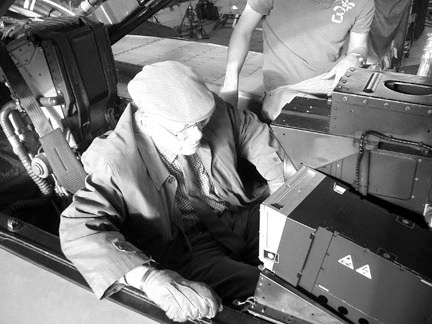
“It wasn’t like this on Blenheims!”
ex-Blenheim navigator Brian Dutton inspects the Navigator’s cockpit of a Tornado GR4
Pat O’Connor who was the Squadron Engineering Officer in 1962 and some of whose memoir of that time appear later in this issue says that he recalls “Banjo” (mentioned in previous issues) as “A very likeable rogue!” I have also heard from Ted Casson (1960s) who stayed behind after the Canberra disbandment in 1970 to run the Wildenrath Open Day that year. Congratulations (or is it condolences?!) to Ken McGowan (1950s) who has just taken over as Hon Sec. of the York RAFA branch and also as Hon Sec of the RAFA Yorkshire Eastern Region. Many thanks to Snip Parsons for some photographs of his time as a Hunter pilot in the late ‘50s. Our erstwhile Vice President Tom Boyle (1990s) was unable to attend the Reunion as he’s stuck in Taif, in Saudi with BAe awaiting the arrival of 48 Typhoons. A couple of others who were prevented from attending the Reunion by the inconvenience of work were Douglas Moule (1990s) who was actring as Deputy Chief Pilot of EasyJet at Luton, and Mike Murtagh (1990s) who was dispatched to Istanbul at short notice by the CAA.
Mike Levy has very kindly sent me a copy of his logbook recording his adventures flying Mosquitoes in the late 1940s (his memoir appeared in issues 3, 4 and 5 of the Old Crusader). Welcome to the Association to Dennis Rusell who served with the Squadron as a Mosquito navigator in 1946. I’ve also had a substantial correspondence with Bob Broad and Geoff Steggall about their adventures on the Squadron in the 1950s. I’ve also been in touch with Sam D’Arcy on the same subject. Andy Cawthorne wrote to say that he recalled the Squadron Spitfire at Oldenburg (I will write up the story soon!) and also added that he’s pleased that we have at least made contact with the National Service Association. I have to admit that I haven’t yet got any further than just making contact, but I do hope to put an advert for the 14 Squadron Association in the NSA magazine some time soon
I am very pleased indeed to have tracked down the “founding father” of the 14 Squadron Association Don Francis. Don joined 14 Squadron in Amman in 1940 and served with the unit throughout the Middle East/Mediterranean war as an engine fitter. It was Don who started things going with an advert in RAF News in 1983 and arranged what he thought was a “one off” reunion at the Victory Services Club. In his own words he was “gobsmacked” to find that the Association is still going strong 25 years later!
Of course one of the reasons that things are still going strong is Joe Lowder (1940s) who held it all together as “temporary” Hon Sec for twenty years. Joe’s been under the knife earlier this year with a heart operations but now he’s back in fine form! I’ve also heard from Peter Henry (1940s) and Dick Froom (1940s) about Merv Hogg’s accident at St Eval in 1945 - see more about this story later.
Derek Watson (‘90s) is now working “in the City” and says “I have started an ex-RAF networking group who meet for beers every 6 weeks or so in the City. Please let folks know who may be interested in joining (free) and attending. Those just ‘thinking’ about leaving are always welcome. We exchange advice and guidance on work beyond the RAF” - if you want to know more I can pass on Derek’s contact details.
I have also spent some time arranging for the Prisoner of War logbook/journal kept by John Kennedy during his time as a PoW to be accepted by the Imperial War Museum. John’s son Robin was keen for his father’s fascinating account of his incarceration to be properly looked after and also available for everyone to see.
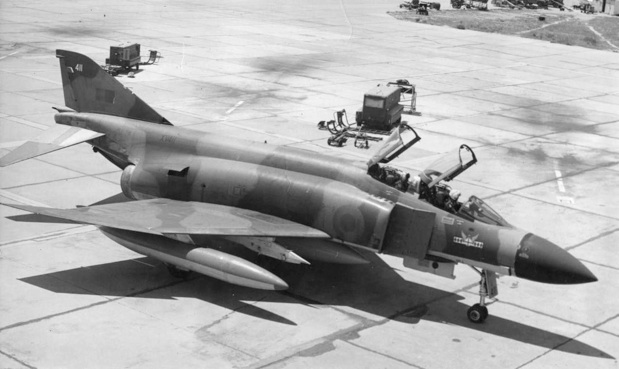
Especially for Derek Smith...
Phantom XV411 on the pan at Decimomannou with Sqn Ldr Roy Booth and Bob Crane
Web Site
The Association website www.14sqn-association.org is going strong and attracts a steady stream of enquiries my way. The site itself will be revamped very shortly - and in particular I want to change the photographs to have more of a “people” theme than an “aircraft” theme on the website. Amongst the enquires I’ve dealt with over the last 6 months have been:
can I provide information about Walter Rice (wartime Marauder W/OpAG) for his great niece [Yes]
can I help help with research into WW1 member for his daughter [Yes]
Would the Association like a a copy of the logbook of Ray Cocks (1940s Mosquito) provided by his grandson [Yes]
can I help an author with his research for a book about the Marauder [Yes - see separate advert later]
can I provide information about Mervin Hogg (wartime Marauder & Wellington pilot) for his nephew [Yes]. This has proved fascinating in that we have tracked down the full report into the fatal accident when Mervin’s Wellington struck the cliff tops at St Eval in April 1945 and also Mervin’s nephew Ian has provided me with a number of photographs which Mervin had taken during his time as a Marauder pilot with the Squadron.
- can I provide information about Bob Francis (wartime Marauder pilot) for his nephew [Yes]
can I provide information about Frank Carberry (wartime W/OpAG on Marauders) for his granddaughter [Yes]
can I provide information about Squadron exchanges - with dates places & units [Yes a bit - but I do need more help with this]
If anyone can give any further information on the above, then I’ll gladly pass it on to the interested parties
Centenary Project
Please keep stuff coming in! I’m interested in memoirs anecdotes photos - in fact anything connected to 14 Squadron - and I’d particularly like to get more from our ex-groundcrew members.
That’s it, Folks!

Mike Napier
Lowesmoor, Great Rollright, CHIPPING NORTON, Oxfordshire OX7 5RR
Memoirs of an Squadron Engineering Officer
Patrick O’Connor - Sqn Engineering Officer 1961-62
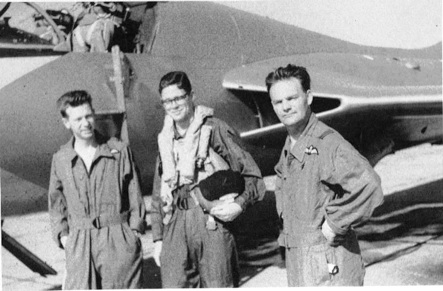
Patrick, seen centre with Mike Wagstaff and Ken Morter, cadging a ride to Cyprus in the Hunter T7
When I joined 14 Sqn. It was equipped with the Mk.6 version of the single-seat Hunter fighter, with four Aden 30mm cannons. Its role was protection of the NATO armies against Warsaw Pact air forces. In 1961 the Cuban missile crisis had brought the world to the brink of all-out nuclear war, so tension was still high. Because of our advanced location at Gutersloh, all of the aircraft were fully armed and loaded all the time. We provided the front line daytime battle flight every day: two pilots and their aircraft were ready to “scramble” at two minutes warning. They would be scrambled any time a Warsaw Pact aircraft flew too near or into the air defence identification zone or “ADIZ”, a band on the map that followed the Cold War frontier. That often happened last thing on Friday afternoons, just to annoy us and prevent us from getting away for the weekend on time. There were two other Hunter squadrons on the station, both flying the FR10 reconnaissance version. I was the only engineer officer on the squadron, responsible for 16 aircraft and about 100 technicians.
The Hunter was a lovely aircraft, both to look at and to fly. If the Javelin could be compared to a SUV, the Hunter was a sleek sports coupe. Technically, it was less complex and demanding than the Javelin, but it had its quirks.
One of the few tricky ones was the engine starting system, which differed from that on the Javelin by using a liquid propellant for the starting turbine. This was isopropyl nitrate (IPN), with the NATO designation AVPIN. IPN is a “monofuel”, which means it needs no additional oxidiser to burn. It just burns, ferociously. It also finds its way through the tiniest leaks, particularly when under high pressure, so fires were commonplace, and one of the groundcrew always had a large asbestos glove available, in addition to the usual fire extinguishers, for engine starts. One day I was in a cockpit to do a check run after an engine change. I pressed the starter button, and heard the usual whirring of the AVPIN pump and cracking of the engine’s high energy electric igniters. Then there was a massive bang, then another, and another. I looked up and saw that the groundcrew were running away. I switched off as quickly as I could, slid the canopy open and leapt down the access ladder. The groundcrew said that I overtook them. The cause of the bangs: an O-ring seal had been omitted when the starter was assembled onto the new engine.
I had a close shave once when one of our aircraft was scheduled to provide a firepower display to a group of senior NATO officers and politicians at one of the ranges. Normally, we flew with the 4Z version of 30mm HE ammunition, but it was known that a small proportion of these rounds exploded before impact with the target. This was considered acceptable for war use, but for demonstrations we had to use the safer 3Z version. My armourers and I knew this, so the aircraft that was prepared for the demo was duly loaded with 3Z. So was the one on standby, just in case.
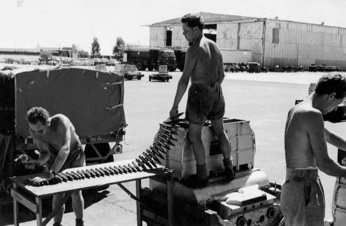
Nicosia - Squadron armourers loading the guns with coloured bullets for Air-to-air firing
The pilot strapped in, started the engine, but there was a problem. He quickly jumped out, strapped into the standby Hunter, started, taxied out and roared down the runway. The armament chief technician came running up to me. “Sir! He’s taken an aircraft with 4Z!” I rushed to the ops room and shouted “Stop him, he’s loaded with 4Z!” They tried to contact him, but by this time he was speeding low-level to the range, and never heard the radio message.
When he returned he was very excited. “It was fantastic! They were exploding right in front of me and all the way to the ground!” he said. I returned to my office to await the call from on high that would blot my career. It never came. A few days later I heard that the armament officer had been targeted for the blame and had been severely reprimanded for not being there to supervise the action. I did not like the man, and the deed had been done, so I just kept my head down.
My bedroom in the mess was at the end of a block, separate from the main mess building. My window looked out onto a copse of pines, on the other side of which was the 14 Sqn. hangar, so bed to work or back was a minute’s walk. It was also just a short stagger to and from the bar and other mess facilities.
Of course, as Guetersloh was home to three Hunter squadrons there were lots of bachelors, so there was always a crowd in the bar as soon as it opened. When I arrived I was the first new posting in for several months, as all postings had been frozen during and after the Cuba missile crisis. Each evening after work I would change for dinner, and walk from my room to dinner in the mess. However, that meant going past the bar, but someone would spot me and insist that I join the crowd assembled there. It took me about a week before I eventually managed to get to the dining room in time for dinner.
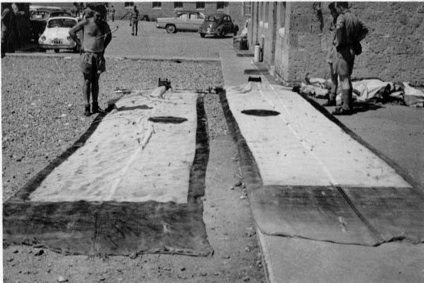
Checking the flag for coloured holes!
We had a splendid crew on 14, and morale was very high. I quickly made friends with all of our pilots. The bachelors included Chris Carr-White, who, being rather shorter than average could withstand unusually high “G” loads when flying, so he was considered quite an ace in mock combat. Doug Barr was a hairy Scot, who earned the nickname “Rudder Barr” when he managed to break the rudder bar of a Hunter during some violent manoeuvre. This was changed to “Spreader Barr” when he flew his aircraft into the spreader bar of a target banner during air-to-air gunnery practice. One weekend morning the old German lady who looked after our rooms rushed into mine, telling me in great agitation to come quickly as my comrade was dead in the bath. I followed her into the bathroom, and there was Doug, fast asleep and stark naked in a cold bath, a truly gruesome sight. It was his way of sleeping off the effects of a party.
We made deployments to other NATO bases, in my time to Denmark and Cyprus. I often flew to and from these in one of the 2-seat T7 Hunters of Station Flight, and I became fairly competent at flying it, though I never quite managed to land one, my pilot saying at the last moment “I have control!” It was customary for pilot’s names to be painted on the aircraft, just below the cockpit, so I had my mine painted on the starboard side of one of the T7s.
After the Russians shot down Gary Power’s U2 reconnaissance aircraft in 1962 military flying quickly became predominantly a low-altitude affair. No longer were the skies covered with high, weaving contrails. Fighters and bombers now flew low to stay under the radar, unless they were making a long transit flight. Low level flying was much more exciting. Sitting in a Hunter doing about 500MPH at a few hundred feet provides a thrill that never fades from the memory.
My most memorable trips were to and from Cyprus, via Orange in the south of France, Malta, and El Adem in Libya. I did that twice, first just in formation with a single F6 to make plans for the squadron visit, then a few weeks later with the whole squadron. At El Adem we stayed over for a day. We drove to the coast and swam in the Med, then next day flew on to Nicosia. On the main visit, 30,000 feet over Cyprus, sixteen Hunters in diamond formation descended in a vertical dive, with the two of us in the T7 right behind watching the island grow beneath us. (You can do it now in the comfort of home, by zooming in with Google Earth).
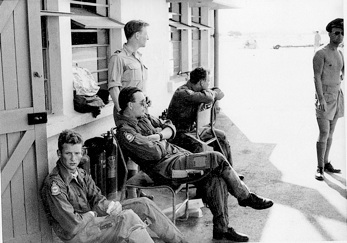
En-route home from Nicosia: waiting for the Boss’ aircraft to be fixed during the stopover at El Adem
We had a wonderful time there, especially as we worked only in the mornings because of the heat. We visited the beach at Kyrenia on the beautiful north coast, and enjoyed the bars in Nicosia. The Middle East Air Force swimming competition was held there during our visit, and we were invited to enter a guest team. One of our pilots, Stu Lumsden, was a very tall, strong fellow, and an excellent swimmer. He won every race, and I came second, so 14 Sqn. easily won the competition.
One weekend three of us hired a yacht from the proprietor of the local bar, and set off to sail along the north coast. There was a problem with the rigging, it was getting dark and blowing, so our captain decided it was safer to return for repairs. We sailed back, then tried to get into Kyrenia bay. But the wind, coming over the hills from the south, just dropped off to flat calm. We were still about a mile out, sails hanging limp, and we could see the lights of the town, but we just could not sail in. So two of us swam. It was a wonderful experience: the water was warm and still, the moon was up, and phosphorescence sparkled and blazed as we swam. We made it to the beach and walked, dripping and just in bathing suits, up to the bar. The owner was aghast when he saw us, but he calmed down when we assured him that his yacht was safe, and he rescued it and us with his motorboat.
On the flight back we were delayed at El Adem, because of a problem with the undercarriage of the CO’s Hunter. On landing he told me that he had had trouble retracting it after take-off, so I had a look around but couldn’t see anything wrong. We decided that for the next leg he would take off first, and the rest of us would follow if he was OK. He roared off down the runway, then flew over a minute later, undercarriage firmly down. We had to sit and wait while he flew around for nearly an hour burning off fuel to get down to landing weight. When he taxied in, furious, I looked into the undercarriage bay and there was a wire hanging loose. I fixed it, he took off again, and up went his wheels. We all quickly strapped into our aircraft and got airborne and in formation for the overwater leg to Malta. At last we arrived back at Guetersloh, breaking through low cloud to see our home runway, welcomingly wet and cool after our long hot absence.
If you have enjoyed reading this article, you can find stories from the rest of Pat’s career in the RAF at: www.lulu.com/content/1267688
see page in History Section
ADVERTISEMENT!
I can recommend a booklet about the Marauder Mk I, which has been recently published in the “Allied Wings” series by author Phil Listemann. Price 13 Euros Obtainable on-line via www.raf-in-combat.com
Obituaries
Raymond Victor Ball
Died October 2007, aged 88
Ray Ball will be remembered fondly by the wartime members of 14 Squadron as one of the men who attended to their culinary needs as they lived the nomadic lifestyle of the RAF in the Middle East. The Squadron’s catering section earned a reputation for ingenuity and resourcefulness through their ability to acquire extra “goodies” for the cooking pot. Ray’s story of “Bebe” the pig, who provided the Squadron’s Forward Flight with a fine pig roast in late 1941 is told in Winged Promises.
Born in Islington in 1919, Ray spent his teenage years working (perhaps appropriately) for German pork butchers in Hornsey and also travelling around Europe on his bicycle. He was called up for the RAF in 1939 and trained as a cook – a trade which included not just cooking, but also butchery and many other skills which would later prove very useful in supplementing the rations on active service. It was while he was training at St Athan that Ray met his wife, but only four days after their wedding in November 1940 he was posted to the Middle East. Ray joined 14 Squadron early in 1941 and soon became expert in making and breaking camp. He had many happy memories of his travels with the Squadron, which took him to Palestine, Trans Jordan, through Egypt and across North Africa. However, it was his time in Iraq in 1941 which provided the fondest memories, and he told many a tale of the good times had at the air station at Habbaniyah. An inveterate storyteller, Ray often retold stories of his time with 14 Squadron, but even in later life, he was still upset at the memory of his many colleagues who were lost during the war. In particular Ray often referred to one of his former COs, the late Wing Commander “Buck” Buchanan who, until his untimely operational death, was a charismatic and flamboyant leader of men.
After the war, Ray returned to the UK and started up a butchery business, first in the Kings Cross area of London and then, until recent times, in the countryside of Surrey. Ray was a great supporter of the 14 Squadron Association and attended many of the Reunions held at the VSC.
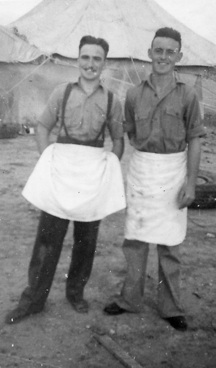
Ray Ball (on the left) and unidentified chum “somewhere in the desert”, 1941-43
Harry Barnes
Died September 2007, aged 92
Harry Barnes joined 14 Squadron at Amman in 1937 as an aircraft fitter, and served with the Squadron through the expansion of the Squadron in the late ‘30s to the first years of the war and up until 1942. When he joined the Squadron it was still flying Gordon biplanes, and it was the usual for the aircraft fitters to fly as crews in these aircraft. In fact on several occasions Harry had flown in the very aircraft featured in The Old Crusader” a few issues back which had taxied into a car (though he was not in it at the time!).
A Halton apprentice, Harry claimed that his posting to Amman came with the shortest notice ever; he was having a beer in a pub in Salisbury one evening (while stationed at Old Sarum) when the SWO walked in and told him his kit was on the truck outside. The truck took him to Southampton to meet the troop ship where he signed a pre-written postcard saying “Dear Mum & Dad am going overseas, can't tell you where, will write later.” On arrival in Amman as an AC2 he was directed to his billet where the senior person was a 40 year old AC1 who advised him that he should not speak until spoken to. One morning sometime later, Harry was woken at 0200 and told to prepare the CO's aircraft for flight in half an hour. At the appointed hour the CO appeared and climbed into the cockpit, but before starting the engine he told Harry to put himself on a charge for not shaving!
Soon after the outbreak of war in 1939, Harry and the Squadron deployed to Port Sudan, for operations against Italian forces in the Red Sea and Abyssinia. Harry’s vivid description of the harsh conditions at Port Sudan is recorded in Winged Promises.
Harry Barnes left 14 Squadron in the Western Desert of Egypt in 1942, and was posted back to UK to a Canadian fighter squadron commanded by Douglas Bader. He remained in the RAF until he retired in 1966 as a Warrant Officer. Harry continued to take an interest in the fortunes of his old Squadron and was one of the original members of the 14 Squadron Association when it started up in 1983
Harry’s son David adds: I wish the Squadron well, as I have supped a few beers with them when they visited Goose Bay for the annual low level flying exercises 89 - 91.
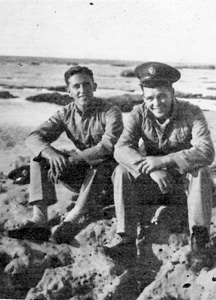
Harry Barnes (on the left) and unidentified chum, Aboukir 1935
Derrick Coleman
Died September 2007, aged 84
I am also very sorry to report the passing of Derrick Coleman who died in September 2007 aged 84. Derrick was a wartime Lancaster navigator - a Pathfinder no less - whose tour with 35 Squadron was foreshortened when he was shot down by a night fighter over Holland and he became a PoW. He joined 14 Squadron at Wahn (Cologne) on Mosquitoes in 1947, a tour which I imagine was refreshingly less exciting than his wartime ones!



